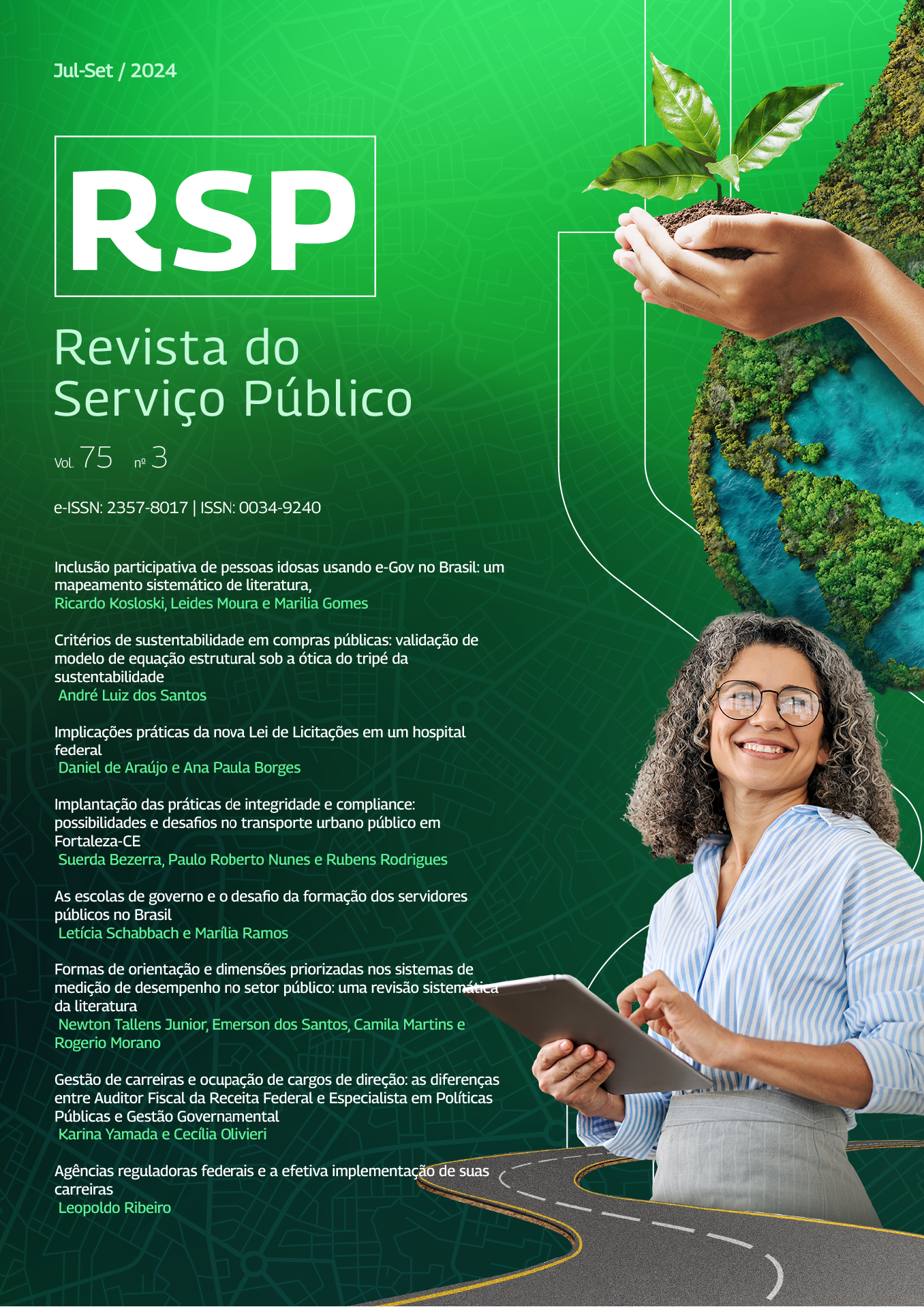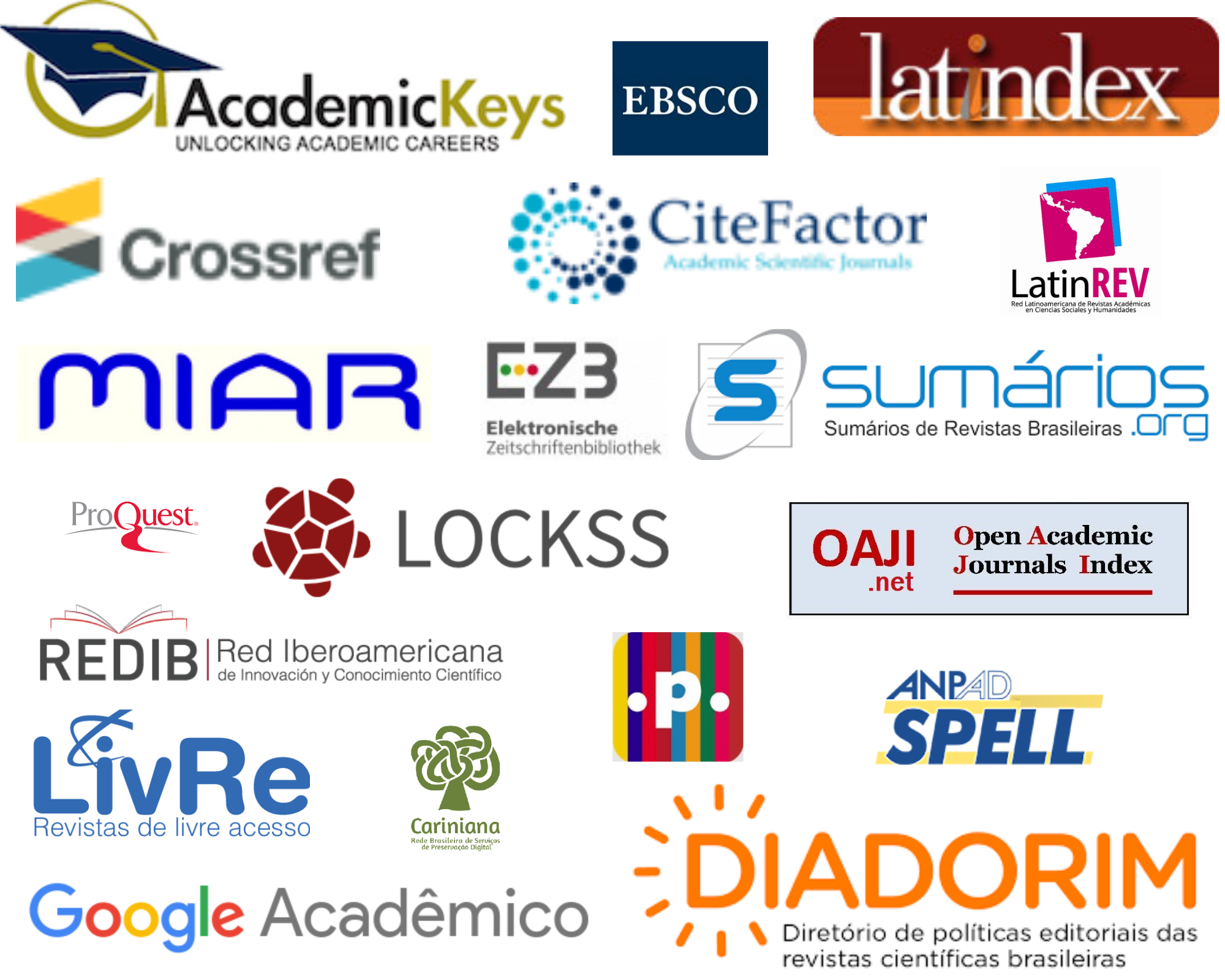Inclusão participativa de pessoas idosas usando e-Gov no Brasil
um mapeamento sistemático de literatura
DOI:
https://doi.org/10.21874/rsp.v75i3.10457Palavras-chave:
e-Gov, Pessoa idosa, brecha digital, Inclusão social, mapeamento sistemático de literaturaResumo
A população de pessoas idosas cresce no Brasil e em todo mundo, onde os serviços de e-Gov são uma realidade e podem ser entendidos como uma forma de engajamento na vida política do país. Este trabalho apresenta um consolidado da literatura sobre as influências vivenciadas pelas pessoas idosas ao usar serviços de e-Gov. Mapeamento sistemático de literatura e TEMAC foram usados para o levantamento de informações na literatura. Bibliometria e Mapas conceituais para a consolidação dos resultados obtidos. Resultados mostram várias naturezas de fatores, desde os tecnológicos como disponibilidade de conectividade e equipamentos, até os sociais como idade, educação etc . Eles podem ser importantes motivadores ou barreiras ao uso deste tipo de serviço. Aprofundar este conhecimento é importante para fomentar uma inclusão participativa de pessoas idosas à atual sociedade da informação.Downloads
Referências
ABAD-ALCALÁ, L.; LLORENTE-BARROSO, C; SÁNCHEZ-VALLE, M.; VIÑARÁS-ABAD, M.; PRETEL-JIMÉNEZ, M. Electronic government and online tasks: Towards the autonomy and empowerment of senior citizens. El Profesional de la Información, v. 26, n. 1, p. 34, 4 jan. 2017. DOI: https://doi.org/10.3145/epi.2017.ene.04. Acesso em 29 dez. 2021.
ALFALAH, A.; CHOUDRIE, J.; SPENCER, N. Older Adults Adoption, Use and Diffusion of E-Government Services in Saudi Arabia, Hail City: A Quantitative Study. Em: HAWAII INTERNATIONAL CONFERENCE ON SYSTEM SCIENCES. 2017. DOI: https://doi.org/10.24251/HICSS.2017.357. Acesso em 28 dez. 2021.
AL-MUWIL A., Weerakkody, V., El-haddadeh, R. et al. Balancing Digital-By-Default with Inclusion: A Study of the Factors Influencing E-Inclusion in the UK. Information Systems Frontiers, v. 21, n. 3, p. 635–659, 2019. DOI: https://doi.org/10.1007/s10796-019-09914-0. Acesso em 24 jul. 2019.
ALMUWIL, A.; WEERAKKODY, V.; EL-HADDADEH, R. A Conceptual Study of the Factors Influencing e-inclusion. p. 12, 2011. Disponível em: <https://api.semanticscholar.org/CorpusID:59320022>. Acesso em 24 jul. 2021.
AL-SHAFI, S.; WEERAKKODY, V. Adoption of Wireless Internet Parks: An Empirical Study in Qatar. p. 17, 2008. Disponível em: <http://bura.brunel.ac.uk/handle/2438/8505>. Acesso em 5 jun. 2021.
BALBE, R. DA S. Uso de tecnologias de informação e comunicação na gestão pública: exemplos no governo federal. Revista do Serviço Público, v. 61, n. 2, p. 189–209, 27 jan. 2014. DOI: https://doi.org/10.21874/rsp.v61i2.45.Disponívelem: https://revista.enap.gov.br/index.php/RSP/article/view/45. Acesso em: 23 dez. 2022.
BATAINEH, M.; AKIER, R.; ABU SHANAB, E. Can E-Government Empower Jordanian Citizens and Reinforce Citizenship? International Journal of Electronic Governance, v. 10, n. 4, p. 1, 2018. DOI: https://doi.org/10.1504/IJEG.2018.10014530. Acesso em: 3 jan. 2022.
Becker, J. et al. Social Inclusiveness of Electronic Public Service Delivery in Germany - A Quantitative Analysis. p. 10, 2008. AMCIS 2008 Proceedings, 19. Disponível em <https://aisel.aisnet.org/amcis2008/19/>. Acesso em: 3 ago. 2023.
BECKER, J.; NIEHAVES, B.; ORTBACH, K. Does the answer lie in collaboration? - A case study on e-government and societal aging. p. 13, 2009. Disponivel em < http://aisel.aisnet.org/ecis2008/18>. Acesso em: 19 jan. 2022.
BÉLANGER, F.; CARTER, L. The Effects of the Digital Divide on E-Government: An Empirical Evaluation. th Hawaii International Conference on System Sciences, p. 7, 2006. DOI: https://doi.org/10.1109/HICSS.2006.464. Acesso em: 27 dez. 2021.
BÉLANGER, F.; CARTER, L. The impact of the digital divide on e-government use. Communications of the ACM, v. 52, n. 4, p. 132–135, abr. 2009. DOI: https://doi.org/10.1145/1498765.1498801. Acesso em: 30 dez. 2021.
BONACIN, R., Melo, A.M., Simoni, C.A.C., Baranauskas, M.C. Accessibility and interoperability in e-government systems: outlining an inclusive development process. Universal Access in the Information Society, v. 9, n. 1, p. 17–33 mar. 2010. DOI: https://doi.org/10.1007/s10209-009-0157-0 . Acesso em: 29 nov. 2023.
BOURQUE, P.; FAIRLEY, R. E. (Eds.). SWEBOK: guide to the software engineering body of knowledge. Version 3.0 ed. Los Alamitos, CA: IEEE Computer Society, 2014. ISBN: 978-0-7695-5166-1. Acesso em: 1 abr. 2023.
BRASIL. Estatuto da Pessoa Idosa., 2003. Disponível em: <http://www.planalto.gov.br/ccivil_03/leis/2003/L10.741.htm>. Acesso em: 28 mai. 2024
BRASIL. INSS regulamenta nova prova de vida automática. (2023). Disponível em: <https://www.gov.br/secom/pt-br/assuntos/obrasilvoltou/cuidado/inss-regulamenta-nova-prova-de-vida-automatica>. Acesso em: 2 nov. 2023.
BROWN, C. L. G-8 collaborative initiatives and the digital divide: readiness for e-government. Proceedings of the 35th Annual Hawaii International Conference on System Sciences. Anais... In: PROCEEDINGS OF THE 35TH ANNUAL HAWAII INTERNATIONAL CONFERENCE ON SYSTEM SCIENCES, (2002). DOI: https://doi.org/10.1109/HICSS.2002.994085. Acesso em: 1 jan. 2023.
CAMARANO, A. A.; MARINHO, A. (Eds.). Novo regime demográfico: uma nova relação entre população e desenvolvimento? Rio de Janeiro: IPEA, 2014. ISBN: 978-85-7811-229-5. Acesso em: 12 fev. 2022.
CAPPELLE, M. C. A.; MELO, M. C. de O. L.; GONÇALVES, C. A. Análise de conteúdo e análise de discurso nas ciências sociais. Organizações Rurais & Agroindustriais, [S. l.], v. 5, n. 1, 2003. Disponível em: https://revista.dae.ufla.br/index.php/ora/article/view/251. Acesso em: 12 dez. 2022.
CHANG, S.-I. YEN, D.C., CHANG, IC. et al. Study of the digital divide evaluation model for government agencies–a Taiwanese local government’s perspective. Information Systems Frontiers, v. 14, n. 3, p. 693–709, jul. 2012. DOI: https://doi.org/10.1007/s10796-011-9297-x. Acesso em: 29 dez. 2021.
CHANIAS, S.; MYERS, M. D.; HESS, T. Digital transformation strategy making in pre-digital organizations: The case of a financial services provider. The Journal of Strategic Information Systems, v. 28, n. 1, p. 17–33, mar. 2019. DOI: https://doi.org/10.1016/j.jsis.2018.11.003. Acesso em 24 jul. 2021.
CHARLTON, J. I. Nothing about us without us: disability oppression and empowerment. 3. 3. ed. Berkeley, Calif.: Univ. of California Press, 2004. ISBN: 978-0-520-22481-0. Acesso em: 16 ago. 2023.
CHOUDRIE, J.; GHINEA, G.; SONGONUGA, V. N. Silver Surfers, E-government and the Digital Divide: An Exploratory Study of UK Local Authority Websites and Older Citizens. Interacting with Computers, v. 25, n. 6, p. 417–442, 1 nov. 2013. DOI: https://doi.org/10.1093/iwc/iws020. Acesso em: 30 dez. 2021.
COSTANZI, R. N.; ANSILIERO, G. Evolução recente e alguns determinantes da proteção social dos idosos na América Latina e no Brasil. Revista do Serviço Público, v. 60, n. 3, p. 219–240, 2014.DOI: https://doi.org/10.21874/rsp.v60i3.24. Disponível em: https://revista.enap.gov.br/index.php/RSP/article/view/24. Acesso em: 27 jan. 2023.
DODEL, M.; AGUIRRE, F. Digital inequalities’ impact on progressive stages of e-government development. Proceedings of the 11th International Conference on Theory and Practice of Electronic Governance. Anais... In: ICEGOV ’18: 11TH INTERNATIONAL CONFERENCE ON THEORY AND PRACTICE OF ELECTRONIC GOVERNANCE. Galway Ireland: ACM, (2018). DOI: https://doi.org/10.1145/3209415.3209475 Acesso em: 30 dez. 2021
FECHER, B.; FRIESIKE, S. Open Science: One Term, Five Schools of Thought. SSRN Electronic Journal, 2013. DOI: https://doi.org/10.2139/ssrn.2272036. Acesso em10 jun. 2023.
FREIRE, A. P.; CASTRO, M. DE; FORTES, R. P. DE M. Acessibilidade dos sítios web dos governos estaduais brasileiros: uma análise quantitativa entre 1996 e 2007. Revista de Administração Pública, v. 43, n. 2, p. 395–414, abr. 2009. DOI: https://doi.org/10.1590/S0034-76122009000200006. Acesso em: 7 jan. 2022.
GALIN, D. Software Quality Assurance: Form Theory to Implementation. Harlow, England; New York: Pearson Education Limited, 2004. 590 p. ISBN 978-0-201-70945-2. Acesso em: 28 nov. 2022
GARCIA, A. C. B.; MACIEL, C.; PINTO, F. B. A Quality Inspection Method to Evaluate E-Government Sites. Em: WIMMER, M. A. et al. (Eds.). Electronic Government. Lecture Notes in Computer Science. Berlin, Heidelberg: Springer Berlin Heidelberg, v. 3591, p. 198–209, 2005. DOI: https://doi.org/10.1007/11545156_19. Acesso em: 28 dez. 2021.
GARCIA-GARCIA, L. M.; GIL-GARCIA, J. R. Reconsidering the importance of context for the success of digital government: the case of legal vulnerability and extreme poverty in the provision of migration services at the Southern Mexican border. Proceedings of the 19th Annual International Conference on Digital Government Research: Governance in the Data Age. Anais... In: DG.O ’18: 19TH ANNUAL INTERNATIONAL CONFERENCE ON DIGITAL GOVERNMENT RESEARCH. Delft The Netherlands: ACM, 30 maio 2018. DOI: https://doi.org/10.1145/3209281.3209290. Acesso em: 30 dez. 2021.
GELL, N. M.; Rosenberg, D. E.; Demiris, G.; LaCroix, A.Z; Patel, K. V. Patterns of Technology Use Among Older Adults With and Without Disabilities. The Gerontologist, v. 55, n. 3, p. 412–421, jun. 2015. DOI: https://doi.org/10.1093/geront/gnt166 . Acesso em: 15 mai.2024.
GRIGORYEVA, I.; SHUBINSKIY, M.; MAYOROVA, E. ICT as a driver for senior citizens’ social inclusion. Proceedings of the 8th International Conference on Theory and Practice of Electronic Governance. Anais... In: ICEGOV2014: 8TH INTERNATIONAL CONFERENCE ON THEORY AND PRACTICE OF ELECTRONIC GOVERNANCE. Guimaraes Portugal: ACM, 27 out. 2014. DOI: https://doi.org/10.1145/2691195.2691260. Acesso em: 29 dez. 2021.
GUPTA, K. P.; BHASKAR, P.; SINGH, S. Prioritization of factors influencing employee adoption of e-government using the analytic hierarchy process. Journal of Systems and Information Technology, v. 19, n. 1/2, p. 116–137, (2017). DOI: https://doi.org/10.1108/JSIT-04-2017-0028. Acesso em: 6 mai. 2021.
HARVEY, M.; HASTINGS, D. P.; CHOWDHURY, G. Understanding the costs and challenges of the digital divide through UK council services. Journal of Information Science, p. 016555152110406, (2021). DOI: https://doi.org/10.1177/01655515211040664. Acesso em: 27 dez. 2021.
HENNEN, L. et al. (Eds.). European E-Democracy in Practice. Cham: Springer International Publishing, 2020. ISBN 978-3-030-27183-1. Acesso em: 8 dez. 2020.
HEPBURN, P. A. A New Governance Model for Delivering Digital Policy Agendas: A Case Study of Digital Inclusion Amongst Elderly People in the UK. International Journal of E-Planning Research, v. 7, n. 3, p. 36–49, (2018). DOI: https://doi.org/10.4018/IJEPR.2018070103. Acesso em: 29 dez. 2021.
HOLGERSSON, Jesper; SÖDERSTRÖM, Eva. Bridging the gap: exploring elderly citizens' perceptions of digital exclusion. In: European Conference on Information Systems (ECIS), 27., 2019, Stockholm & Uppsala. Proceedings. Stockholm; Uppsala: ECIS, 2019. Disponível em: https://aisel.aisnet.org/ecis2019_rp/28. ISBN 978-1-7336325-0-8. Acesso em: 28 dez. 2021.
HONG, S.; CHOI, M. How are Baby Boomers Different from Older Adults in Terms of Their E-Government Services Use in South Korea? Journal of Gerontological Social Work, v. 63, n. 8, p. 837–849, (2020). DOI: https://doi.org/10.1080/01634372.2020.1816590. Acesso em: 27 dez. 2021.
ISO/IEC, I. T. S. ISO 25000, Software engineering — Software product Quality Requirements and Evaluation (SQuaRE) — Guide to SQuaRE, 2005, [s.l: s.n.]. Disponível em: https://www.iso.org/standard/35683.html. Acesso em 21 mai 2016.
KHAN, E., JOSE, E.; KHAN, E.; ALEISA, E. E-Services using any phone amp; user’s voice: Bridging Digital Divide amp; help global development (2012). International Conference on Information Technology and e-Services. Anais... In: 2012 INTERNATIONAL CONFERENCE ON INFORMATION TECHNOLOGY AND E-SERVICES, (2012). DOI: 10.1109/ICITeS.2012.6216609. Acesso em: 7 jan. 2022.
KHAN, G. F.; MOON, J.; SWAR, B.; ZO, H.; RHO, J.J. E-government service use intentions in Afghanistan: technology adoption and the digital divide in a war-torn country. Information Development, v. 28, n. 4, p. 281–299, (2012a). DOI: https://doi.org/10.1177/0266666912438879. Acesso em: 12 mar.2022.
KITCHENHAM, B. A.; BUDGEN, D.; BRERETON, P. Evidence-based software engineering and systematic reviews. 1. ed. Boca Raton: CRC Press, 2016. Disponível em: https://www.perlego.com/book/1644454/evidencebased-software-engineering-and-systematic-reviews-pdf. Acesso em: 7 dez. 2021.
MACAYA, J. F. M. RIBEIRO, M. M.; JEREISSATI, T.; DOS REIS LIMA, C.; CUNHA, M. A. Gendering the digital divide: The use of electronic government services and implications for the digital gender gap. Information Polity, v. 26, n. 2, p. 131–146, (2021). DOI: https://doi.org/10.3233/IP-200307 . Acesso em: 5 jan. 2023.
MARTINS, R. Do Cairo a Nairóbi: 25 anos da agenda de população e desenvolvimento no Brasil. Revista Brasileira de Estudos de População, v. 36, 2 dez. 2019. DOI: https://doi.org/10.20947/S0102-3098a0094. Acesso em: 15 jun. 2022.
MENDES, J. As Tecnologias de Informação e Comunicação no Quotidiano Social da Pessoa Idosa: Breve Revisão Narrativa. Interações: Sociedade e as novas modernidades, n. 36, p. 100–112, (2019). DOI: https://doi.org/10.31211/interacoes.n36.2019.a4. Acesso em: 26 dez. 2022.
MENSAH, I. K.; ZENG, G.; LUO, C. The Effect of Gender, Age, and Education on the Adoption of Mobile Government Services: International Journal on Semantic Web and Information Systems, v. 16, n. 3, p. 35–52, (2020). DOI: https://doi.org/10.4018/IJSWIS.2020070103. Acesso em: 27 mar. 2023.
MORTE-NADAL, T.; ESTEBAN-NAVARRO, M. A. Digital Competences for Improving Digital Inclusion in E-Government Services: A Mixed-Methods Systematic Review Protocol. International Journal of Qualitative Methods, v. 21, p. 160940692110709, (2022). DOI: https://doi.org/10.1177/16094069211070935. Acesso em: 2 jun. 2022.
MOUSAVI, S. A.; PIMENIDIS, E.; JAHANKHANI, H. Cultivating trust - An electronic-government development model for addressing the needs of developing countries. International Journal of Electronic Security and Digital Forensics, v. 1, n. 3, p. 233, 2008. DOI: https://doi.org/10.1504/IJESDF.2008.020942. Acesso em: 30 dez. 2021.
NIEHAVES, B.; GORBACHEVA, E.; PLATTFAUT, R. The digital divide vs. the e-government divide: do socio-demographic variables (still) impact e-government use among onliners? In: European Conference on Information Systems, 2012. Preceedings,p. 13, 2012. Disponível em: https://api.semanticscholar.org/CorpusID:18448122. Acesso em 29 dez. 2021.
ONU, Benchmarking E-government: A Global Perspective: acessing the progress of the UN members state. New York: United Nations, 2022. Disponível em: https://doi.org/10.18356/9789210016322. Acesso em: 23 abr. 2024.
PAZMIÑO-SARANGO, M.; NARANJO-ZOLOTOV, M.; CRUZ-JESUS, F. Assessing the drivers of the regional digital divide and their impact on eGovernment services: evidence from a South American country. Information Technology & People, v. ahead-of-print, n. ahead-of-print, (2021). DOI: https://doi.org/10.1108/ITP-09-2020-0628. Acesso em: 5 fev. 2022.
PCHLER, N. A.; WIBELINGER, L. M.; BERTOLIN, T. E. Bem-estar na multidimensionalidade do envelhecimento humano. [s.l.] Ed. Méritos, 2015. ISBN: 978-85-8200-47-2. Disponivel em: https://www.meritos.com.br/livros/147-livro-Bem-estar-na-multidimensionalidade-do-envelhecimento-humano--Meritos-Editora.pdf. Acesso em: 26 dez. 2022.
PÉREZ-AMARAL, T.; VALAREZO, A.; LÓPEZ, R. GARÍN-MUÑOZ, T. Digital divides across consumers of internet services in Spain using panel data 2007–2019. Narrowing or not? Telecommunications Policy, v. 45, n. 2, p. 102093, mar. 2021. DOI: https://doi.org/10.1016/j.telpol.2020.102093. Acesso em: 29 dez. 2021.
PINTO, F.; MACADAR, M. A.; PEREIRA, G. V. The potential of eParticipation in enlarging individual capabilities: a conceptual framework. Information Technology for Development, v. 29, n. 2–3, p. 276–298, (2023). DOI: https://doi.org/10.1080/02681102.2022.2136129. Acesso em: 29 nov. 2023.
PORTAL DEDUÇÃO. GovTech Maturity Index, 2022. Disponível em: <https://www.deducao.com.br/index.php/gov-br-faz-com-que-brasil-conquiste-o-segundo-lugar-do-mundo-em-maturidade-digital-do-governo/>. ISBN: 978-1-4648-1765-6. Acesso em: 21 nov. 2022.
SAHRAOUI, S. E‐inclusion as a further stage of e‐government? Transforming Government: People, Process and Policy, v. 1, n. 1, p. 44–58, mar. 2007. DOI: https://doi.org/10.1108/17506160710733698. Acesso em 29 jul.2021.
SÁNCHEZ VALLE, M.; LLORENTE BARROSO, C. Desafíos de la administración electrónica para la inclusión de las personas mayores en la sociedad digital. Revista Española de la Transparencia, n. 16, p. 217–243, 29 abr. 2023. DOI: 10.51915/ret.239. Acesso em: 25 nov. 2023.
SCANNAVINO, K. R. F. et al. Revisão Sistemática da Literatura em Engenharia de Software: teoria e prática. Rio de Janeiro. Elsevier, 2017. ISBN: 8535285970.
SCOPUS. Scopus_ContentCoverage_Guide_WEB.pdf., 2020. Disponível em: ttps://www.elsevier.com/products/scopus/content#0-content-coverage. Acesso em: 31 ago. 2022.
SCOPUS. Scopus: Comprehensive, multidisciplinary, trusted abstract and citation database. , 2023. Disponível em: <https://www.elsevier.com/products/scopus>. Acesso em: 11 nov. 2023
SEIFERT, A.; SCHLOMANN, A; SCHELLING, H.R.; RIETS, C. The use of mobile devices for physical activity tracking in older adults’ everyday life. Digital Health, v. 3, p. 205520761774008. (2017). DOI: https://doi.org/10.1177/2055207617740088 . Acesso em: 15 abr. 2024.
SEIFERT, A.; COTTEN, S. R.; XIE, B. A Double Burden of Exclusion? Digital and Social Exclusion of Older Adults in Times of COVID-19. The Journals of Gerontology: Series B, v. 76, n. 3, p. e99–e103. (2021). DOI: https://doi.org/10.1093/geronb/gbaa098. Aesso em: 5 ago. 2022.
SERRANO-CINCA, C.; MUÑOZ-SORO, J. F.; BRUSCA, I. A Multivariate Study of Internet Use and the Digital Divide*: Internet Use and Digital Divide. Social Science Quarterly, v. 99, n. 4, p. 1409–1425. (2018). DOI: https://doi.org/10.1111/ssqu.12504. Acesso em: 5 jan. 2022.
TAVARES, R. Construindo mapas conceituais. Ciências & Cognição, v. 12, p. 72-85, 2007. ISSN 1806-5821. Disponível em: https://pepsic.bvsalud.org/pdf/cc/v12/v12a08.pdf. Acesso em: 28 ago. 2022.
TELES, A.; JOIA, L. A. Assessment of digital inclusion via the actor-network theory: The case of the Brazilian municipality of Piraí. Telematics and Informatics, v. 28, n. 3, p. 191–203, (2011). DOI: https://doi.org/10.1016/j.tele.2010.09.003. Acesso em: 28 nov. 2023.
ONU. World population ageing. New York: United Nations, 2020. Disponível em: https://www.un.org/en/development/desa/population/publications/pdf/ageing/WorldPopulationAgeing2019-Report.pdf. ISBN: 978-92-1-148325-3. Acesso em: 28 mai. 2024.
VASCONCELOS, A. M. N.; GOMES, M. M. F. Transição demográfica: a experiência brasileira. Epidemiologia e Serviços de Saúde, v. 21, n. 4, p. 539–548, dez. 2012. DOI: https://doi.org/10.5123/S1679-49742012000400003. Acesso em: 17 set. 2022.
VIAL, G. Understanding digital transformation: A review and a research agenda. The Journal of Strategic Information Systems, v. 28, n. 2, p. 118–144, (2019). DOI: 10.1016/j.jsis.2019.01.003. Acesso em: 24 jul. 2021.ZUPIC, I.; ČATER, T. Bibliometric Methods in Management and Organization. Organizational Research Methods, v. 18, n. 3, p. 429–472, (2015). DOI: https://doi.org/10.1177/1094428114562629. Acesso em: 5. jun. 2021.
Downloads
Publicado
Como Citar
Edição
Seção
Licença
Copyright (c) 2024 Revista do Serviço Público

Este trabalho está licenciado sob uma licença Creative Commons Attribution-NonCommercial-ShareAlike 4.0 International License.
- A RSP adota a licença Creative Commons (CC) do tipo Atribuição – Uso Não-Comercial (BY-NC).
- A licença permite que outros remixem, adaptem e criem obra licenciada, sendo proibido o uso com fins comerciais.
- As novas obras devem fazer referência ao autor nos créditos e não podem ser usadas com fins comerciais, porém não precisam ser licenciadas sob os mesmos termos dessa licença.
- Ao publicar o artigo na RSP, o autor cede e transfere para a ENAP os direitos autorais patrimoniais referentes ao artigo.
- O artigo publicado na RSP não poderá ser divulgado em outro meio sem a devida referência à publicação de origem.
- O autor que tiver o artigo publicado na RSP deverá assinar o Termo de Concessão de Direitos Autorais (em momento oportuno a editoria da Revista entrará em contato com o autor para assinatura do Termo).



